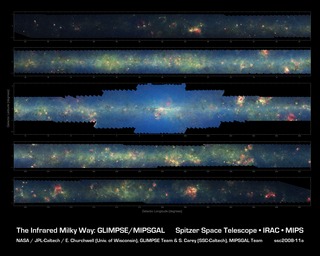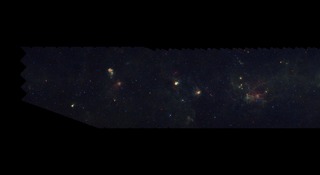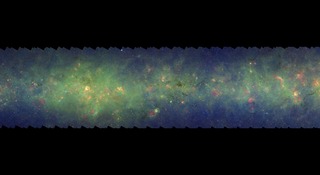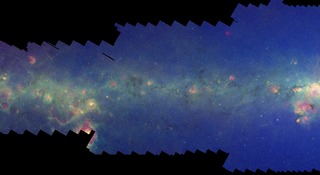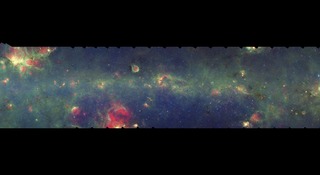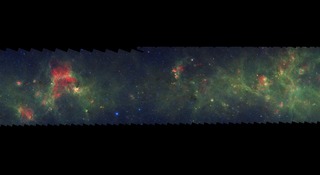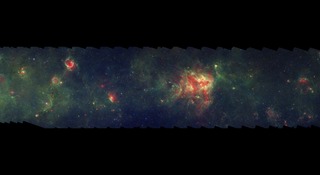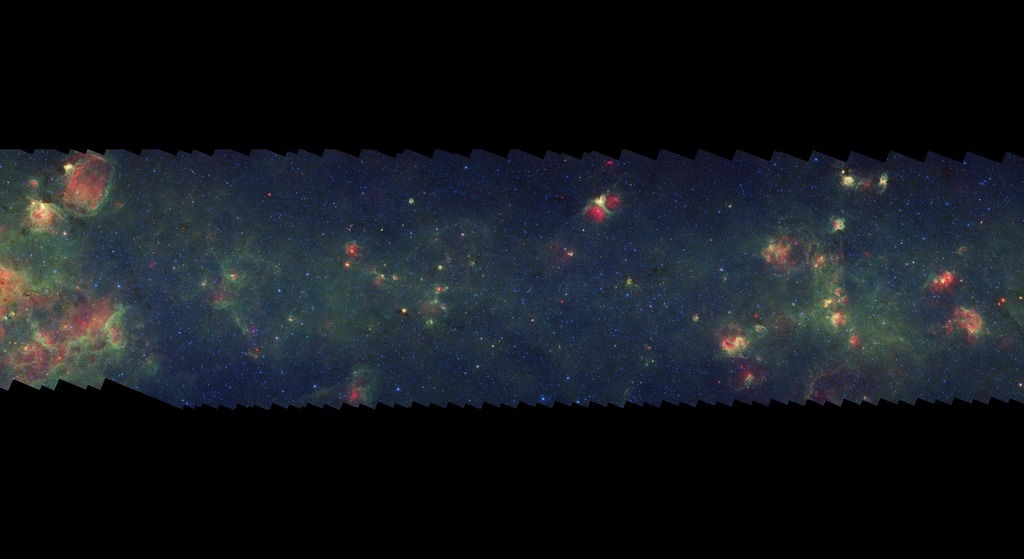
Credit: NASA/JPL-Caltech/Univ. of Wisconsin
Observation • • ssc2008-11a13
ssc2008-11a13
This is one segment of an infrared portrait of dust and stars radiating in the inner Milky Way. More than 800,000 frames from NASA's Spitzer Space Telescope were stitched together to create the full image, capturing more than 50 percent of our entire galaxy.
As inhabitants of a flat galactic disk, Earth and its solar system have an edge-on view of their host galaxy, like looking at a glass dish from its edge. From our perspective, most of the galaxy is condensed into a blurry narrow band of light that stretches completely around the sky, also known as the galactic plane.
This segment extends through the constellations Norma and Circinus. The flat band of green running through this region is mostly dust in the distant disk of the Milky Way galaxy. The drop-off of star formation at the left edge of the image corresponds to our sightline along the outer boundary of the Norma spiral arm. In visible light the foreground dust renders this area nearly featureless and dark with only a scattering of nearby stars.
The swaths of green represent organic molecules, called polycyclic aromatic hydrocarbons, which are illuminated by light from nearby star formation, while the thermal emission, or heat, from warm dust is rendered in red. Star-forming regions appear as swirls of red and yellow, where the warm dust overlaps with the glowing organic molecules. The blue specks sprinkled throughout the photograph are Milky Way stars.
This survey segment spans galactic longitudes of 318.7 to 327.0 degrees and is centered at a galactic latitude of 0 degrees. It covers about two vertical degrees of the galactic plane.
This is a three-color composite that shows infrared observations from two Spitzer instruments. Blue represents 3.6-micron light and green shows light of 8 microns, both captured by Spitzer's infrared array camera. Red is 24-micron light detected by Spitzer's multiband imaging photometer. This combines observations from the Galactic Legacy Infrared Mid-Plane Survey Extraordinaire (GLIMPSE) and MIPSGAL projects.
About the Object
- Name
- Milky Way • Galactic Plane
- Type
- Galaxy > Component > Disk
- Nebula > Type > Interstellar Medium
- Nebula > Type > Star Formation
- Galaxy
Color Mapping
| Band | Wavelength | Telescope |
| Infrared | 3.6 µm | Spitzer IRAC |
| Infrared | 8.0 µm | Spitzer IRAC |
| Infrared | 24.0 µm | Spitzer MIPS |
Astrometrics
- Position (J2000)
- RA =15h 25m 27.8s
- Dec = -56° 47' 10.7"
- Field of View
- 8.3 x 4.5 degrees
- Orientation
- North is 33.7° left of vertical
